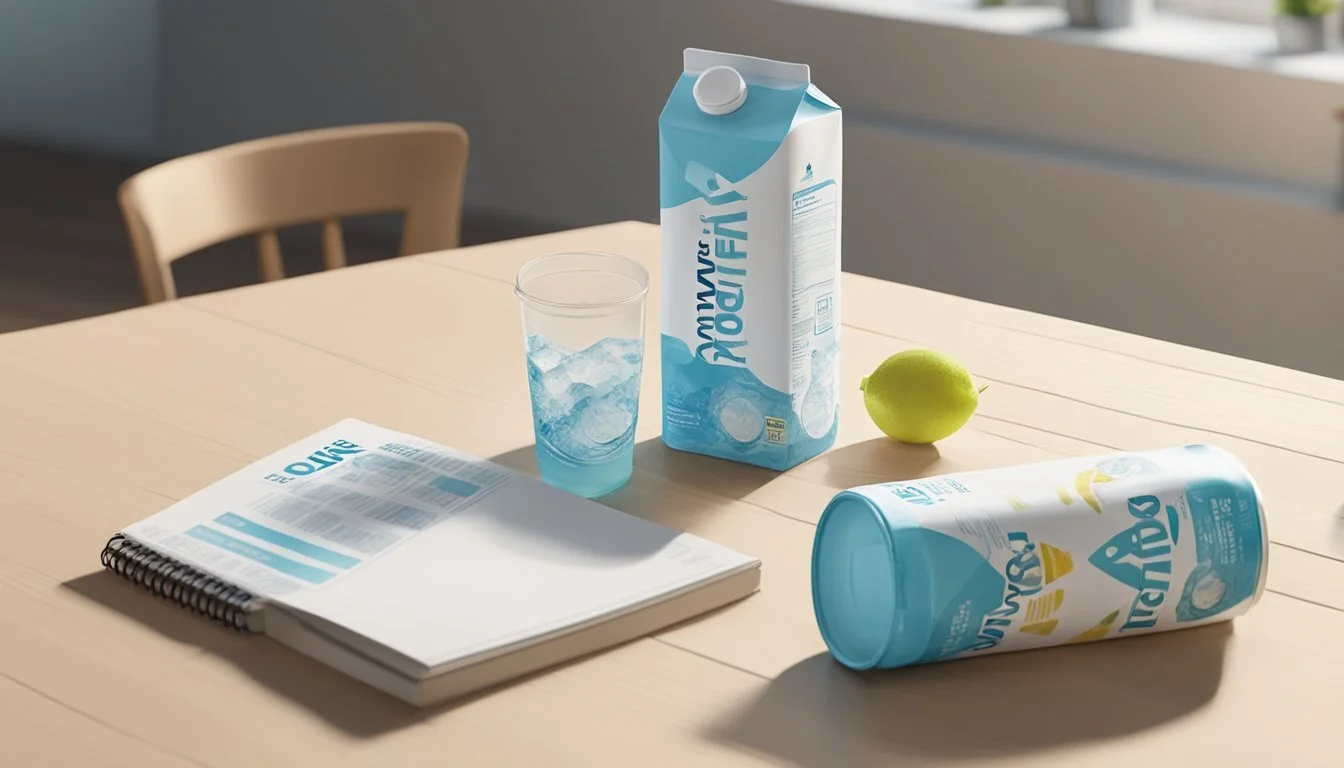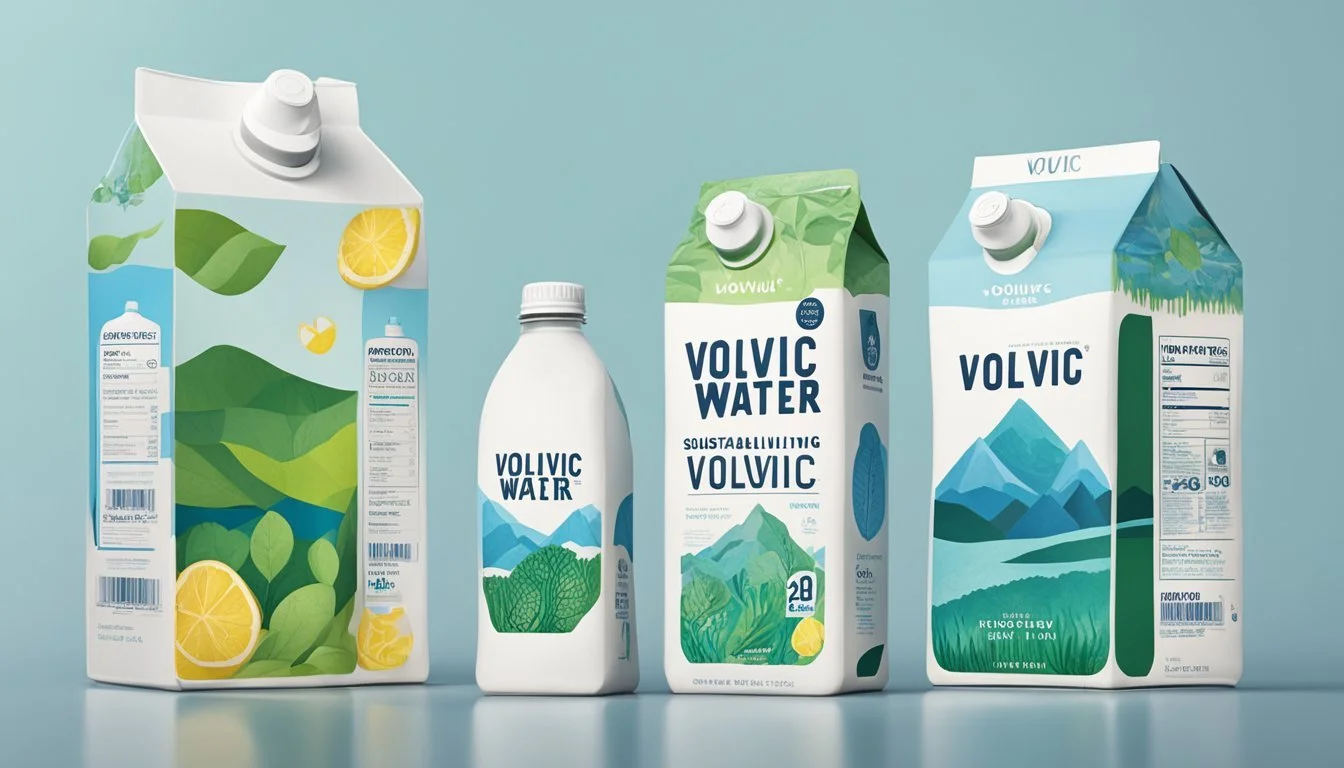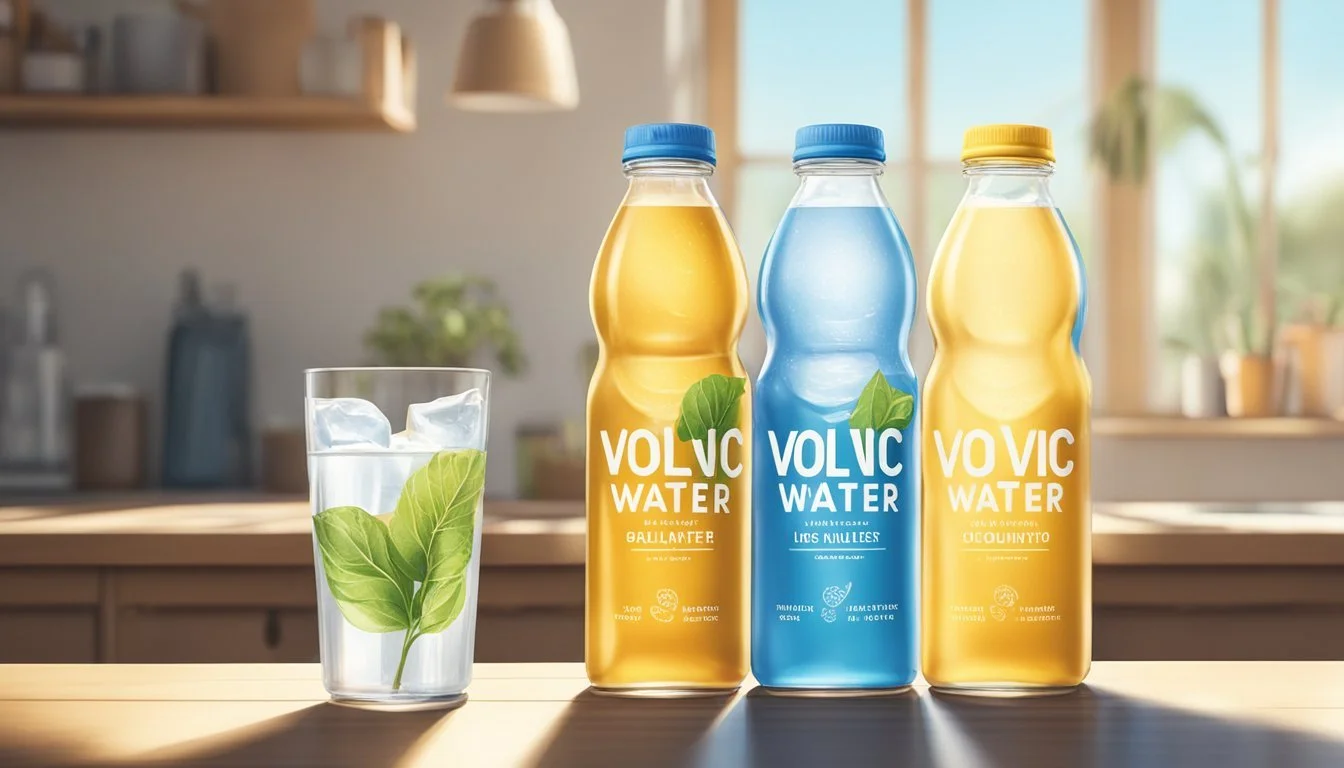Boxed Water vs. Volvic
A Comprehensive Comparison of Bottled Waters
In the realm of hydration, consumers today are faced with a plethora of options that extend beyond the traditional plastic bottled water. Boxed Water offers an alternative, highlighting sustainability with its predominantly paper-based containers. They present a promise of a reduced carbon footprint, while still providing the convenience of portable water. On the other hand, Volvic is known for its natural volcanic filtration and distinct mineral composition. It is a brand associated with natural purity and is representative of the classic bottled water sector.
While Boxed Water claims a composition of 74 percent paper, 1 percent aluminum, and 25 percent plastic to maintain waterproofing, Volvic touts the unique journey its water takes through volcanic rock, which naturally filters and infuses it with minerals. The environmental aspect of Boxed Water's packaging challenges the traditional use of plastics, which are notoriously detrimental when not properly recycled. Conversely, Volvic focuses on the natural quality and taste of its water, something that consumers have come to trust and enjoy over the years.
As consumers become more environmentally conscious, the decision between boxed and bottled water becomes more than a matter of taste—it's a statement about sustainability and health. Deciding which bottled water is better requires a consideration of these factors, as well as the individual's priorities regarding environmental impact and mineral content. The following analysis compares Boxed Water and Volvic on these grounds, aiming to provide insights that help consumers make an informed choice about their drinking water.
Understanding Boxed and Bottled Water
Selecting between boxed and bottled water involves understanding the nature of each product, their water sources, and the methods used to deliver hydration in an eco-conscious manner.
What Is Boxed Water?
Boxed water refers to drinking water packaged in cartons primarily made from paper. Companies like Boxed Water Is Better use cartons with a typical composition of 74% paper, 1% aluminum, and 25% plastic to maintain structural integrity and water-proofing. This type of packaging has emerged as an alternative with a potentially smaller carbon footprint compared to traditional plastic water bottles.
What Is Volvic Water?
Volvic water is a brand of bottled water sourced from springs located near a chain of volcanoes in the Auvergne region of France. It filters through volcanic rock, which adds unique minerals and results in pure spring water. The bottling process of Volvic ensures the water maintains the same purity and mineral content as it has at the source. The company uses PET bottles for packaging, which can be recycled.
Comparing Water Sources
The sources of water for both boxed and bottled water vary significantly:
Boxed water: Typically sourced from municipal sources, and treated through methods such as ultraviolet, carbon, and reverse-osmosis filtration before being boxed.
Volvic water: Sourced from a natural spring water reserve, and arguably requires less filtration due to the natural purification process as it seeps through volcanic rock.
These different sources have their own environmental impacts and health benefits associated with their naturally occurring minerals or lack thereof. The choice between these water types may also reflect one's preference for the taste and the value they place on the source of the water they consume for hydration.
Health and Safety Considerations
When evaluating Boxed Water and Volvic for health and safety considerations, consumers should focus on potential contaminants, adherence to water safety standards, and any health benefits linked to hydration.
Potential Contaminants
Both Boxed Water and Volvic need to ensure their products are free from harmful contaminants. Contaminants to monitor include arsenic, chlorine, and fluoride, which at certain levels can pose health risks. Boxed Water's packaging is made predominantly of paper, which may be less likely to leach chemicals compared to some plastics. However, Volvic, being sourced from natural springs, could be subject to naturally-occurring contaminants like arsenic, although levels are typically low and within safety standards.
Water Safety Standards
The Food and Drug Administration (FDA) regulates the safety of bottled water such as Volvic, and these standards are based on the Environmental Protection Agency (EPA) standards for tap water. Companies must adhere to these standards to deem their water safe for consumption. Boxed Water must also follow FDA's good manufacturing practices for processing and bottling.
Hydration and Health Benefits
Hydration is critical for maintaining health, and both Boxed Water and Volvic offer clean drinking water that can aid in staying hydrated. There are no conclusive studies proving additional health benefits of bottled water over tap water beyond the provision of necessary hydration, assuming the source water meets safety standards. Both Boxed Water and Volvic market themselves as providing purified water that contributes to maintaining hydration.
Environmental Impact and Sustainability
Choosing between Boxed Water and Volvic hinges on understanding their individual and relative impacts on the environment, taking into account the sustainability of their packaging materials, the carbon footprint incurred through transportation, and the effectiveness of recycling and waste reduction strategies.
Packaging Materials
Boxed Water utilizes paper-based cartons which are primarily sourced from sustainably managed forests, bearing certifications like the Forest Stewardship Council (FSC). The composite structure of these cartons includes about 75% paper, 20% plastic, and 5% aluminum, and they are often marketed as being eco-friendlier than traditional plastic bottles. Volvic, on the other hand, primarily uses plastic (PET) bottles, which can be fully recyclable. The debate around packaging also involves the presence of microplastics, which are a concern in many plastic products.
Carbon Footprint and Transportation
The transportation of both Boxed Water and Volvic contributes to their carbon footprint. The weight and volume of Boxed Water packaging might allow for more efficient transport due to its square shape, potentially reducing carbon emissions per unit shipped. Meanwhile, Volvic, imported from France, often travels long distances to reach consumers, which could result in a larger carbon footprint per bottle. However, specific figures on emissions vary and depend on multiple factors such as transportation means and distances covered.
Recycling and Waste Reduction
Boxed Water claims their cartons are 100% recyclable, yet the reality of carton recycling reveals that not all regions have the facilities to process them effectively. Recycling rates for cartons may thus be lower than for PET plastics. PET bottles, like those used by Volic, are widely accepted by recycling programs and can be turned into new products more readily. However, there is a significant concern with plastic bottles, as they are often not recycled and can contribute to environmental pollution.
Packaging and Consumer Experience
In the battle between Boxed Water and Volvic, consumers weigh options on packaging material as well as the sensory and practical experience offered by both brands.
Design and Convenience
Boxed Water presents an alternative to traditional plastic bottles with its paper-based, carton design. The box is rectangular and flat-sided, allowing for ease of stacking and storage. Additionally, it's equipped with a spout and cap similar to those found on a milk carton. In contrast, Volvic water is sold in curved plastic bottles, which could be more prone to rolling when laid down but are ergonomic for handling and drinking.
Taste and Palate
The taste of water from Boxed Water and Volvic is perceived to be clean and refreshing by consumers, though some report that water from paper boxes can occasionally carry a faint flavor from its container. Volvic, sourced from French volcanic springs, is often described as having a unique mineral composition that can enhance its taste profile for those with a discerning palate preferring natural mineral water.
Accessibility and Availability
Boxed Water has marked its territory as a sustainable choice, but its availability is more limited when compared to plastic-bottled counterparts. Volvic is widely distributed and commonly found in various retail locations, making it more accessible to the average consumer. Those who prioritize eco-friendliness might find Boxed Water less readily available, but its presence is increasing as consumers demand more environmentally-friendly alternatives. Some may turn to reusable water bottles as the most sustainable option, bypassing the need for single-use containers altogether.
Market Analysis and Brands Overview
As the bottled water industry continues to expand, market analysis and brand differentiation become vital in understanding consumer choices. Within this diverse market, Boxed Water and Volvic represent two distinctive offerings amidst a sea of competitors vying for consumer attention.
Popular Water Brands
Boxed Water and Volic stand out for their unique branding and environmental initiatives. However, they are among a significant roster of popular brands. Dasani and Aquafina, owned by Coca-Cola and PepsiCo respectively, hold substantial shares in the market due to wide distribution and marketing. Nestlé's Poland Spring, Deer Park, and Arrowhead Mountain Spring Water also have a strong presence in the U.S. market.
European brands such as Evian and San Pellegrino cater to consumers looking for premium options, with Fiji Water and Smartwater also competing in this space. Speciality and regional brands like Mountain Valley Spring Water, Icelandic Glacial, and Acqua Panna emphasize their unique source origins.
Other notable competitors include:
Essentia: Known for its ionized alkaline water
Core Hydration: Promotes perfect pH water
Just Water: Stresses eco-friendly packaging
Penta: Offers ultra-purified water
Eternal Water: Comes from natural springs
Ethos Water: Part of Starbucks, with a charitable angle
Life WTR: A premium purified water brand by PepsiCo, focused on design and artistry
Gatorade: Broadening from sports drinks to water segments
Consumer Preferences
Consumer preferences are shifting towards products that offer health benefits and sustainability. Brands that successfully convey a message of purity, health enhancements, or environmental stewardship tend to resonate more with consumers.
Boxed Water, with its eco-friendly carton packaging, targets environmentally conscious buyers, whereas Volvic, sourced from French volcanoes, attracts those seeking water with natural mineral content. Additionally, products like Ethos Water, which contributes to global water access initiatives, are appealing due to their social impact missions.
Flavored and functional waters introduced by Nestlé, Coca-Cola, and Gatorade are gaining traction among consumers seeking variety and added health benefits, like electrolytes and vitamins. The popularity of certain brands like Smartwater and Essentia may be attributed to their enhanced water offerings that promise additional hydration and wellness advantages.
Innovations in Water Consumption
Innovations in water consumption focus on the development of new packaging alternatives, advancements in purification technology, and the sustainability of future water sources. These changes strive to reduce environmental impact and improve water quality.
Emerging Alternatives to Traditional Bottled Water
Consumers now have more choices beyond the classic plastic or glass bottles for their drinking water. Boxed Water, for instance, presents an alternative with its 92% plant-based package, which stands out in the marketplace for its high renewable content. Companies have been experimenting with various packaged water options such as aluminum cans, acknowledging their higher recycling rates compared to plastics. These alternatives seek not only to provide convenience but also to instill a change in consumer habits towards more eco-friendly products.
Technological Advances in Water Treatment
In the realm of water treatment, technological innovations are playing a pivotal role. Among these technologies, ultraviolet light purification systems and reverse-osmosis filtration are breaking grounds. These systems promise to remove contaminants to a significant degree, and some of them even manage to maintain beneficial mineral content in the water. They are employed in both municipal water supplies and in the production of bottled mineral water, ensuring safer and cleaner consumption.
Future of Sustainable Water Packaging
The sustainability of water packaging is a major concern moving forward. Anticipating a shift, industry players are exploring materials that are both BPA-free and biodegradable. Research is being conducted into bio-based plastics and other materials that can be composted after use. The goal is to find solutions for bottled water - including types such as mineral water and alternatives akin to the wine industry's use of traditional glass bottles - that are kind to the planet while still providing consumers with various pH levels and types of water they prefer. The packaging of the future must balance consumer demands with environmental stewardship.
Conclusion
This section distills the analysis into considerations that consumers can weigh when choosing between Boxed Water and Volvic bottled water.
Final Comparisons and Consumer Recommendations
When evaluating Boxed Water and Volvic, one must consider various factors, including packaging materials, environmental impact, and taste. Boxed Water typically utilizes a carton resembling a milk carton, made from a composite of paper, aluminum, and plastic film, with the intention of improving sustainability. Volvic, on the other hand, uses polyethylene terephthalate (PET) bottles, a common material for bottled water that is recyclable but still contributes to plastic waste.
The type of water offered by these brands also differs. Volvic is known for its natural water, sourced from volcanoes, with a unique mineral composition that influences its water taste. Boxed Water promotes its product as a purified drinking water, with less distinction in taste profile but a strong emphasis on environmental consciousness.
Consumers must consider:
The importance of taste preference: Does the unique mineral profile of Volvic's natural water appeal to them?
The value they place on environmentally friendly packaging: Is the boxed format's lower plastic content preferable over PET bottles?
The type of water they prioritize: Are they looking for mineral-rich natural water, or do they prefer purified water?
The Bottom Line
Discussing Boxed Water versus Volvic boils down to assessing personal values and preferences. Those who heavily weigh environmental implications may lean toward Boxed Water's carton-based solution. In contrast, individuals who prioritize the unique taste from volcanic minerals might find Volvic's bottled water more appealing.
Product Packaging Water Type Taste Profile Boxed Water Carton (74% paper, 1% aluminum, 25% plastic) Purified drinking water Neutral Volvic PET bottles (recyclable, but plastic-intensive) Natural mineral water Distinctive
Ultimately, neither brand provides a definitive solution to all considerations, but each offers attributes that can align with different consumer priorities.






